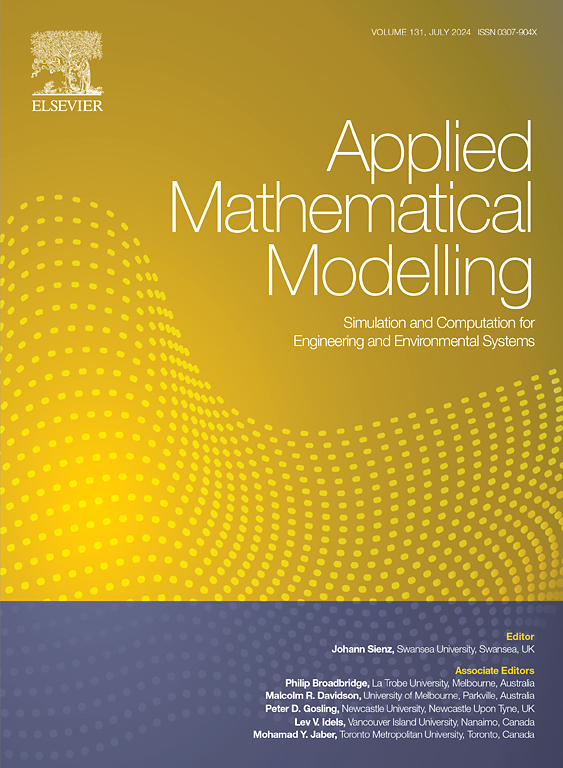Simulation of gas mixture dynamics in a pipeline network using explicit staggered-grid discretization
IF 4.4
2区 工程技术
Q1 ENGINEERING, MULTIDISCIPLINARY
引用次数: 0
Abstract
We develop an explicit staggered finite difference discretization scheme for simulating the transport of highly heterogeneous gas mixtures through pipeline networks. This study is motivated by the proposed blending of hydrogen into natural gas pipelines to reduce end use carbon emissions while using existing pipeline systems throughout their planned lifetimes. Our computational method accommodates an arbitrary number of constituent gases with very different physical properties that may be injected into a network with significant spatiotemporal variation. In this setting, the gas flow physics are highly location- and time- dependent, so that local composition and nodal mixing must be accounted for. The resulting conservation laws are formulated in terms of pressure, partial densities and flows, and volumetric and mass fractions of the constituents. We include non-ideal equations of state that employ linear approximations of gas compressibility factors, so that the pressure dynamics propagate locally according to a variable wave speed that depends on mixture composition and density. We derive compatibility relationships for network edge boundary values that are more complex than for a homogeneous gas. The simulation method is evaluated on initial boundary value problems for a single pipe and a small network, is cross-validated with a lumped element simulation, and used to demonstrate a local monitoring and control policy for maintaining allowable concentration levels.
使用显式交错网格离散法模拟管网中的气体混合物动力学
我们开发了一种显式交错有限差分离散方案,用于模拟高度异质混合气体在管道网络中的传输。这项研究的动机是在天然气管道中掺入氢气,以减少最终使用过程中的碳排放,同时利用现有的管道系统在其规划的寿命期内。我们的计算方法适用于任意数量的物理性质迥异的组成气体,这些气体可能会注入具有显著时空变化的管网。在这种情况下,气体流动的物理特性高度依赖于位置和时间,因此必须考虑局部成分和节点混合。由此产生的守恒定律是根据压力、部分密度和流量以及成分的体积分数和质量分数制定的。我们采用了非理想状态方程,对气体压缩系数进行了线性近似,从而使压力动态根据取决于混合物成分和密度的可变波速进行局部传播。我们推导出了网络边缘边界值的相容性关系,这种关系比均质气体更为复杂。该模拟方法对单管和小型网络的初始边界值问题进行了评估,并与集合元素模拟进行了交叉验证,还用于演示维持允许浓度水平的局部监测和控制策略。
本文章由计算机程序翻译,如有差异,请以英文原文为准。
求助全文
约1分钟内获得全文
求助全文
来源期刊

Applied Mathematical Modelling
数学-工程:综合
CiteScore
9.80
自引率
8.00%
发文量
508
审稿时长
43 days
期刊介绍:
Applied Mathematical Modelling focuses on research related to the mathematical modelling of engineering and environmental processes, manufacturing, and industrial systems. A significant emerging area of research activity involves multiphysics processes, and contributions in this area are particularly encouraged.
This influential publication covers a wide spectrum of subjects including heat transfer, fluid mechanics, CFD, and transport phenomena; solid mechanics and mechanics of metals; electromagnets and MHD; reliability modelling and system optimization; finite volume, finite element, and boundary element procedures; modelling of inventory, industrial, manufacturing and logistics systems for viable decision making; civil engineering systems and structures; mineral and energy resources; relevant software engineering issues associated with CAD and CAE; and materials and metallurgical engineering.
Applied Mathematical Modelling is primarily interested in papers developing increased insights into real-world problems through novel mathematical modelling, novel applications or a combination of these. Papers employing existing numerical techniques must demonstrate sufficient novelty in the solution of practical problems. Papers on fuzzy logic in decision-making or purely financial mathematics are normally not considered. Research on fractional differential equations, bifurcation, and numerical methods needs to include practical examples. Population dynamics must solve realistic scenarios. Papers in the area of logistics and business modelling should demonstrate meaningful managerial insight. Submissions with no real-world application will not be considered.
 求助内容:
求助内容: 应助结果提醒方式:
应助结果提醒方式:


